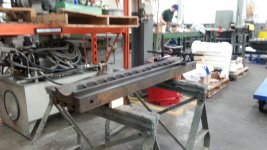What is the minimum practical size for a straight edge to scrape in a Bridgeport Series 1 9x42? I am looking at dgfoster's 18" and 26" featherweight castings. Machine Tool Reconditioning mentions methods for using shorter SEs on longer surfaces but doesn't provide any guidance on the limits of these techniques.
To be clear, I'm sure a SE as long as the longest surface is ideal, but suppose a guy is doing this purely for enjoyment and would rather spend his time and energy than his money on it, how short is too short for the purpose?
To be clear, I'm sure a SE as long as the longest surface is ideal, but suppose a guy is doing this purely for enjoyment and would rather spend his time and energy than his money on it, how short is too short for the purpose?







